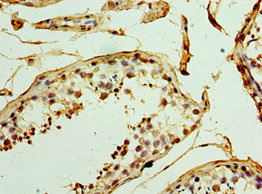UCP1 antibody
GTX10983
ApplicationsWestern Blot, ImmunoHistoChemistry, ImmunoHistoChemistry Paraffin
Product group Antibodies
TargetUCP1
Overview
- SupplierGeneTex
- Product NameUCP1 antibody
- Delivery Days Customer9
- Application Supplier NoteWB: 1:1,000. IHC-P: 1:500. *Optimal dilutions/concentrations should be determined by the researcher.Not tested in other applications.
- ApplicationsWestern Blot, ImmunoHistoChemistry, ImmunoHistoChemistry Paraffin
- CertificationResearch Use Only
- ClonalityPolyclonal
- ConjugateUnconjugated
- Gene ID7350
- Target nameUCP1
- Target descriptionuncoupling protein 1
- Target synonymsSLC25A7, UCP, mitochondrial brown fat uncoupling protein 1, solute carrier family 25 member 7, thermogenin, uncoupling protein 1 (mitochondrial, proton carrier)
- HostRabbit
- IsotypeIgG
- Protein IDP25874
- Protein NameMitochondrial brown fat uncoupling protein 1
- Scientific DescriptionMitochondrial oxidative phosphorylation makes possible ATP synthesis using the energy available from substrate oxidation at the respiratory chain. These processes are coupled through the proton electrochemical potential gradient generated during the transfer of electrons from the substrate to oxygen. The uncoupling proteins (UCPs) are mitochondrial inner membrane proteins that are considered to be transporters functioning as enzymatic uncouplers of oxidative phosphorylation. They are capable of returning protons pumped by the respiratory chain to the mitochondrial matrix. Uncoupling proteins currently comprise UCP1, UCP2, UCP3, UCP4, and UCP5. UCP1 is a 32 kDa protein that is active as a proton channelforming dimer. It can bind purine nucleotides and is capable of being stimulated by fatty acids. Proton transport by UCP1 has been shown to depend on CoQ (ubiquinone) as an obligatory cofactor. UCP1 is exclusively expressed in BAT in rodents and in neonates where it is regulated by norepinephrine and thyroid hormones. Stimulated BAT is able to dissipate energy as heat via uncoupled mitochondrial respiration. The liberated heat can serve several physiological functions, e.g. for body heating during emergence from hibernation or during cold exposure, for burning body fat and consequently for body weight regulation.
- Storage Instruction-20°C or -80°C,2°C to 8°C
- UNSPSC12352203
References
- Glycosaminoglycan dermatan sulfate supplementation decreases diet-induced obesity and metabolic dysfunction in mice.Read more
- A common East-Asian ALDH2 mutation causes metabolic disorders and the therapeutic effect of ALDH2 activators.Read more
- Maternal Consumption of a Cafeteria Diet during Lactation Leads to Altered Diet-Induced Thermogenesis in Descendants after Exposure to a Western Diet in Adulthood. Pomar CA et al., 2022 May 7, NutrientsRead more
- Protective Effects of Individual and Combined Low Dose Beta-Carotene and Metformin Treatments against High-Fat Diet-Induced Responses in Mice. Stojnic B et al., 2021 Oct 14, NutrientsRead more
- Pleiotropic effects of apolipoprotein A-II on high-density lipoprotein functionality, adipose tissue metabolic activity and plasma glucose homeostasis. Zvintzou E et al., 2019 Jul 26, J Biomed ResRead more
- Combination of Capsaicin and Hesperidin Reduces the Effectiveness of Each Compound To Decrease the Adipocyte Size and To Induce Browning Features in Adipose Tissue of Western Diet Fed Rats. Mosqueda-Solis A et al., 2018 Sep 19, J Agric Food ChemRead more
- Pleiotropic effects of apolipoprotein C3 on HDL functionality and adipose tissue metabolic activity. Zvintzou E et al., 2017 Sep, J Lipid ResRead more
- A combination of resveratrol and quercetin induces browning in white adipose tissue of rats fed an obesogenic diet. Arias N et al., 2017 Jan, Obesity (Silver Spring)Read more
- Gene expression of peripheral blood mononuclear cells is affected by cold exposure. Reynes B et al., 2015 Oct 15, Am J Physiol Regul Integr Comp PhysiolRead more
- Improved metabolic regulation is associated with retinoblastoma protein gene haploinsufficiency in mice. Petrov PD et al., 2015 Jan 15, Am J Physiol Endocrinol MetabRead more



